SEITE 2
W&H Dentalwerk Bürmoos GmbH
SEITE 3
Editorial: Implantology faces new challenges
Dr Friedhelm Heinemann, President of DGZI
SEITE 6
Bone quality, quantity and metabolism in terms of dental implantation
Jochen Fanghänel*, Tomasz Gedrange*, Germany *Department of Orthodontics, Preventive and Pediatric Dentistry, Centre of Dentistry and Oral Health, Ernst Moritz Arndt University of Greifswald, Germany
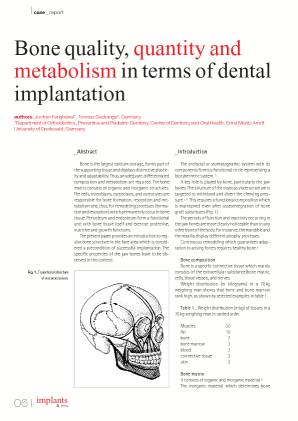
Bone is the largest calcium storage, forms part of the supporting tissue and displays distinctive plasticity and adaptability. Thus, an adequate, differentiated composition and metabolism are required. The bone matrix consists of organic and inorganic structures. The cells, osteoblasts, osteoclasts, and osteocytes are responsible for bone formation, resorption and metabolism and, thus, for remodeling processes (formation and resorption) which permanently occur in bone tissue. Periosteum and endosteum form a functional unit with bone tissue itself and exercise protective, nutritive and growth functions. The present paper provides an introduction to regular bone structure in the face area which is considered a precondition of successful implantation. The specific properties of the jaw bones have to be observed in this context. ...
ePaper
PDF
SEITE 12
Reconstruction of damaged fresh sockets by connective-bone sliver graft from the maxillary tuberosity, to enable immediate dentoalveolar restoration (IDR)ÑA clinical case
JosŽ Carlos Martins da Rosa1, Darcymar Martins da Rosa2, Carla M™nica Zardo3, Ari‡dene Cristina PŽrtile de Oliveira Rosa4, Luigi Canullo5 1 Private Practice in Caxias Do Sul, RS, Brazil
2 Private Practice in Novo Hamburgo, RS, Brazil 3 MSc student o
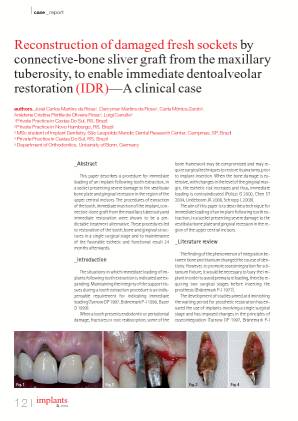
This paper describes a procedure for immediate loading of an implant following tooth extraction, in a socket presenting severe damage to the vestibular bone plate and gingival recession in the region of the upper central incisors. The procedures of extraction of the tooth, immediate insertion of the implant, connective-bone graft from the maxillary tuberosity and immediate restoration were shown to be a predictable treatment alternative. These procedures led to restoration of the tooth, bone and gingival structures in a single surgical stage and to maintenance
of the favorable esthetic and functional result 24 months afterwards. ...
ePaper
PDF
SEITE 15
BEGO Implant Systems GmbH & Co. KG
SEITE 18
Clinical outcomes of flapless implant surgery using a handpiece driven stereolithographic surgical guide
Volkan Arisan*, Z. Cuneyt Karabuda**, Turkey *DDS, Phd, Dr, Istanbul University, Faculty of Dentistry, Department of Oral Implantology, Capa, Istanbul, Turkey
**DDS, Phd, Assoc. Prof Dr, Istanbul University, Faculty of Dentistry,Department of Oral Implant
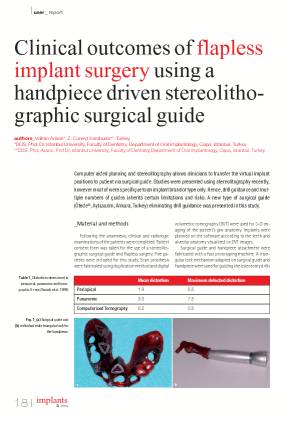
Computer aided planning and stereolitography allows clinicians to transfer the virtual implant positions to patient via surgical guide. Studies were presented using stereolitography recently, however most of were specifique to an implant brand or type only. Hence, drill guidance and multiple numbers of guides inherits certain limitations and risks. A new type of surgical guide (Ötede¨, Aytasarim, Ankara, Turkey) eliminating drill guidance was presented in this study.
ePaper
PDF
SEITE 24
Extraction, immediate implant placement and guided bone regeneration using a flapless approach
Barry K. Bartee, DDS, MD, USA
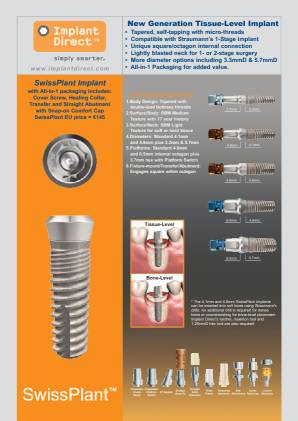
Esthetic requirements for implant supported restorations include the presence of natural soft tissue contours, and to the extend possible, the full presence of the interdental papillae. Regardless of the technique used for tooth extraction, some degree of soft and hard tissue loss is inevitable. The use of guided tissue regeneration membranes over sockets has been shown to be one method to preserve bone after extraction, but most techniques involve the use of large flaps and even vertical incisions to achieve primary closure. Because of the unique features of Cytoplast¨ dense PTFE membranes and the ability of the membranes to remain exposed in the oral cavity without risk of infection, the soft tissue architecture, keratinized tissue width and position of the mucogingival junction adjacent to the socket can be preserved. Using the minimally invasive tunneling technique described in this article facilitates minimally invasive socket reconstruction avoiding vertical incisions and incision of the interdental papillae. The technique described can be used for immediate implant placement, as in this case, or for socket preservation using particulate graft material if a staged approach is desired. ...
ePaper
PDF
SEITE 28
Precautions for using zirconia implant abutments
Moustafa N Aboushelib*, Egypt, and Rien van Paridon**, Netherlands *DDS, MSc, PhD, Dental Biomaterials department, Faculty of Dentistry, Alexandria University, Egypt **DDS, PhD, Materials Science Department, ACTA, University of Amsterdam and the Free Uni
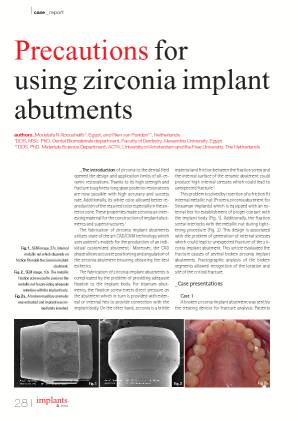
The introduction of zirconia to the dental field opened the design and application limits of all-ceramic restorations. Thanks to its high strength and fracture toughness long span posterior restorations are now possible with high accuracy and success rate. Additionally, its white color allowed better reproduction of the required color especially in the anterior zone. These properties made zirconia an interesting material for the construction of implant abutments and superstructures. ...
ePaper
PDF
SEITE 31
J. Morita Europe GmbH
SEITE 32
Resorption mechanism of an injectable calcium phosphate bone regeneration cementÑRadiographic and histological monitoring
Sergio Alexandre Gehrke, Brazil
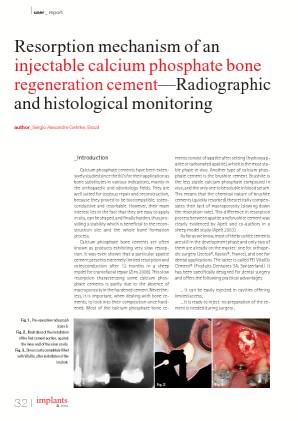
Calcium phosphate cements have been extensively studied since the 80 s for their application as bone substitutes in various indications, mainly in the orthopaedic and odontology fields. They are well suited for osseous repair and reconstruction, because they proved to be biocompatible, osteoconductive and resorbable. However, their main interest lies in the fact that they are easy to apply in situ, can be shaped, and finally harden, thus providing a stability which is beneficial to the reconstruction site and the whole bone formation process. ...
ePaper
PDF
SEITE 38
DGZI Adria Congress on the Isle of Vis
Rolf Vollmer, Rainer Valentin, Germany
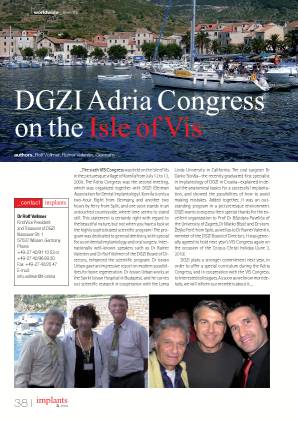
The sixth VIS Congress was held on the Isle of Vis in the picturesque village of Komiìa from July 12 to 13, 2009. The Adria Congress was the second meeting, which was organized together with DGZI (German Association for Dental Implantology). Komiìa is only a two-hour flight from Germany, and another two hours by ferry from Split, and one soon stands in an untouched countryside, where time seems to stand still. This statement is certainly right with regard to the beautiful nature, but not when you have a look at the highly sophisticated scientific program!
ePaper
PDF
SEITE 39
39th International Annual Congress of the DGZI
SEITE 40
5th Arab German Implantology Meeting DGZI in Damascus
Redaktion
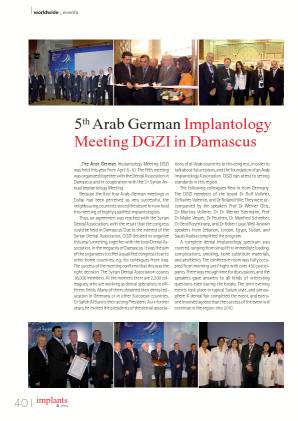
The Arab German Implantology Meeting DGZI was held this year from April 8-10. The fifth meeting was organized together with the Dental Assocation in Damascus and in cooperation with the 3rd Syrian Annual Implantology Meeting. ...
ePaper
PDF
SEITE 42
Saudi ArabiaÑTradition and modern times! 20th Saudi Dental Society and 2nd National Guard ”New Dental EraÓ International Conference 2009, organized in cooperation with the German Association of Dental Implantology (DGZI)
Rolf Vollmer, Germany
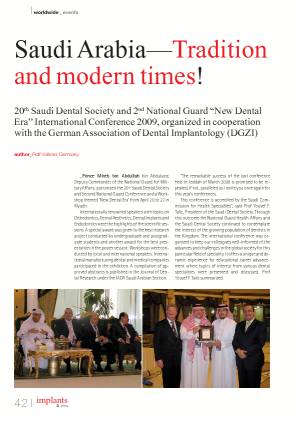
20th Saudi Dental Society and 2nd National Guard ”New Dental EraÓ International Conference 2009, organized in cooperation with the German Association of Dental Implantology (DGZI)
ePaper
PDF
SEITE 45
Selected Events 2009/2010
Redaktion
SEITE 46
Congratulations and Happy Birthday to all DGZI-members around the world
Redaktion
SEITE 47
Manufacturer News
Redaktion
SEITE 50
Imprint
Redaktion
SEITE 52
Sybron Implant Solutions GmbH




